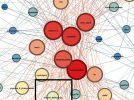Hoopoe
Senior Member (Voting Rights)
One of the candidate genes in the DecodeME preprint.
Curcumin increases PRDX6 expression.
PRDX6 (Tier 1)
• Protein: Peroxiredoxin 6. UniProt. GeneCards. The allele that increases the risk of ME/CFS is
associated with decreasing PRDX6 gene expression.
• Molecular function: Thiol-specific peroxidase that catalyses the reduction of hydrogen
peroxide and organic hydroperoxides. PRDX6 also has phospholipase A2 activity (18) and acts
in antioxidant defence by facilitating repair of damaged cell membranes via reduction of
peroxidised phospholipids (19).
• Cellular function: PRDX6 protects against oxidative stress (20). Cytoplasmic enzyme involved
in phosphatidylcholine synthesis and repair of membrane lipid peroxidation. PRDX6 is not
peroxisomal.
• Link to disease: No genetic diseases known.
• Potential relevance to ME/CFS: Phosphatidylcholine has been reported to be depleted in a
group of people with ME/CFS (21). One study showed increased plasma peroxides in ME/CFS
Curcumin increases PRDX6 expression.

